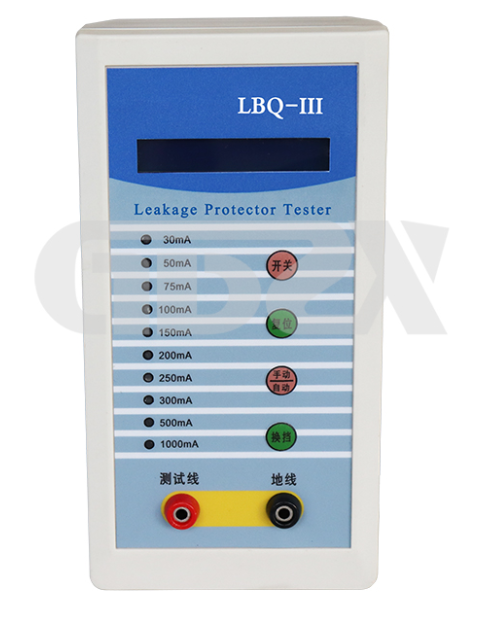NEWSnews
Technical Analysis and Application Guide for LBQ-III Residual Current Device Tester
The LBQ-III Residual Current Device (RCD) Tester is a handheld diagnostic instrument designed for evaluating critical performance parameters of residual current protective devices, including tripping current thresholds, non-tripping current tolerance, and response time. With its compact design, multi-range testing capabilities (0–1000 mA), and high-precision measurement (up to 799 ms resolution), this device serves as an essential tool for field technicians and electrical engineers to ensure compliance with safety standards. This article provides a comprehensive technical overview, operational insights, and application scenarios for professionals in power systems and industrial maintenance.
1. Introduction to the LBQ-III RCD Tester
The LBQ-III tester addresses the growing demand for portable, accurate, and user-friendly solutions in electrical safety testing. Its core functionality revolves around validating RCD performance under simulated fault conditions, ensuring devices operate within IEC 61009 or equivalent regional standards. Key applications include routine maintenance of low-voltage distribution systems, commissioning of new installations, and troubleshooting in residential, commercial, or industrial environments.
2. Core Technical Specifications
The device’s engineering excellence is reflected in its rigorously defined parameters:
Voltage Compatibility: Supports AC 220V/380V systems, aligning with global low-voltage grid standards.
Current Testing Ranges: 10 adjustable precision tiers (30, 50, 75, 100, 150, 200, 250, 300, 500, 1000 mA) to accommodate diverse RCD ratings.
Timing Accuracy: ±0.5% error margin (±2 digits) for tripping time measurement (0–799 ms), critical for verifying fast-acting Type A/AC RCDs.
Environmental Resilience: Operates reliably at 0–40°C with <85% relative humidity, suitable for harsh field conditions.
Ergonomic Design: Compact dimensions (195×101×42 mm) and lightweight construction enable single-handed operation.
3. Functional Advantages for Technicians
3.1 Multi-Device Compatibility
The LBQ-III supports testing across single-phase and three-phase RCD configurations, including:
Domestic Circuit Breakers: Validates GFCI (Ground Fault Circuit Interrupter) devices in residential panels.
Industrial RCDs: Assesses high-sensitivity protective relays in manufacturing facilities.
Portable RCD Adapters: Tests temporary protection devices used in construction sites.
3.2 Intelligent Detection Workflow
Auto-Current Detection: Automatically identifies the minimum tripping current (IΔn) by incrementally increasing test current until RCD activation.
Real-Time LCD Feedback: A 16-character blue-backlit LCD displays instantaneous current and timing data, eliminating manual calculation errors.
3.3 Safety-Enhanced Architecture
Isolated Test Circuits: Test line voltage limited to 250V AC, preventing accidental overvoltage exposure.
Fail-Safe Trigger Logic: Internal algorithms prevent false positives by filtering transient currents during testing.
4. Operational Protocol and Best Practices
Step 1: Pre-Test Configuration
Connect the tester to the RCD’s load terminals using insulated probes.
Select the target current tier based on the RCD’s rated residual current (e.g., 30 mA for residential units).
Step 2: Dynamic Testing Modes
Manual Mode: Technicians manually increment current levels to observe tripping behavior.
Auto-Ramp Mode: The device autonomously sweeps through predefined current steps (e.g., 30→1000 mA) to map RCD response curves.
Step 3: Data Interpretation
Pass/Fail Criteria: Compare measured tripping time (TΔ) against allowable thresholds (e.g., ≤300 ms for 30 mA RCDs at 5×IΔn).
Non-Tripping Verification: Confirm RCD stability at 50% of rated current (e.g., 15 mA for a 30 mA device).
5. Maintenance and Calibration
Periodic Calibration: Recalibrate annually using a certified reference RCD to maintain ≤1% current accuracy.
Battery Management: Replace 9V alkaline batteries when the low-power indicator activates to prevent voltage drift.
Probe Integrity Checks: Inspect test leads for insulation damage before high-current (≥500 mA) tests.
6. Industry-Specific Use Cases
Renewable Energy Systems: Validate RCDs in solar PV arrays where DC fault currents require Type B RCD validation.
Healthcare Facilities: Test medical-grade RCDs with ultra-fast tripping (<40 ms) for ICU power grids.
Data Centers: Perform monthly leakage current audits on UPS-backed RCD panels.
The LBQ-III RCD Tester exemplifies the convergence of portability, precision, and adaptability in modern electrical testing tools. By mastering its functionalities, technicians can systematically enhance grid safety, reduce downtime, and comply with evolving regulatory frameworks. Future iterations may integrate Bluetooth data logging or IoT-enabled predictive maintenance features, but the current model remains indispensable for field diagnostics.
GDZX is a manufacturer of power detection equipment, offering a diverse range of products with comprehensive models and providing professional technical support. Contact us at +86-27-6552607 or +86-17396104357.Website: http://en.gdzxdl.com/






















